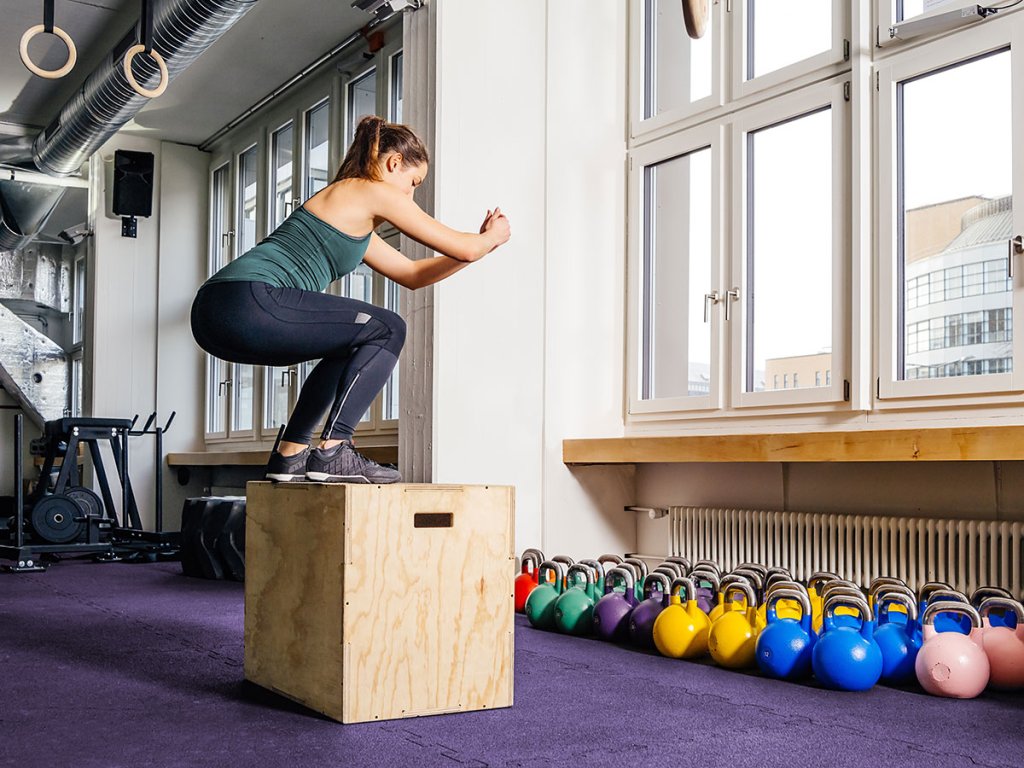We get it — box jumps feel intimidating. But mastering this incredibly effective exercise can help you level up your gym routine, and we’ve got all the tips you need to get started. With some dedication and practice, you’ll be box-jumping like a boss in no time. Let’s get to it!
What are the benefits of box jumping exercises?
Box jumps are a type of plyometric exercise — quick, powerful movements that have three distinct phases:
- Eccentric phase: The eccentric phase is also known as the loading phase. In this phase, your muscles store potential energy. Think of a baseball pitcher pulling his arm back before throwing the ball.
- Amortization phase: This is the transition phase. The muscles that stored up the energy in the eccentric phase stabilize during this time, preparing for the third phase.
- Concentric phase: The concentric phase is also known as the unloading phase. In this phase, your muscles release the stored energy, like when a baseball pitcher completes a throw.
Plyometric exercises like box jumps are used to increase strength, vertical jump height, long jump distance, and running speed, to name a few. Box jumps, in particular, are a great way to improve your overall stability, balance, mobility, and coordination. Bonus: Box jumps can also help improve your cardiovascular health. Whether you’re a distance runner, a powerlifter, or a busy person looking to improve your overall health, a box jump workout can be a valuable addition to your gym routine.
Which muscles are worked with box jumping?
Box jumps work all your leg muscles, including your hamstrings, quads, and calves — and your booty, too. They’re also a go-to exercise for building core strength, which improves your posture, prevents injuries, reduces chronic pain, and improves your overall athletic ability.
Should you do box jumps at the start or the end of a workout?
Box jumps take strength and power, so it’s recommended that you practice your box jumps at the beginning of your workout, after a good warm-up. Your risk of injury goes up when you’re fatigued, so it’s better to tackle these first.
How many sets and reps of box jumps should I do?
The amount of reps and set you do depends on your goals. Are you doing box jumps to increase your strength, or are you jumping for cardio? If getting your heart rate up or increasing endurance is your goal, you’ll want to use a short box. Do more reps with less rest inbetween, and a couple of sets. If boosting strength is your aim, do fewer reps with more rest time, and complete 4–5 sets.
What is the correct box jump form?
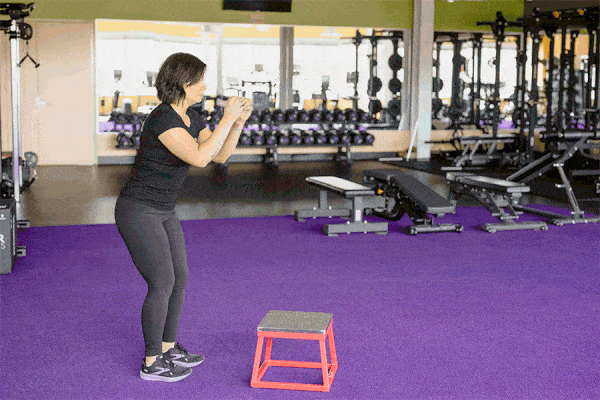
Before we jump in (see what we did there?), let’s talk about form and equipment. To do a box jump, all you need is a good pair of tennis shoes and a plyo box or another flat, sturdy platform that won’t shift around when you land.
Now, here’s how to do a box jump:
- Face the box, standing about six inches away with your feet hip-width apart.
- Bend your knees and push your hips back, swinging your arms behind you to gain momentum.
- Push through your feet and jump in one explosive movement, pulling your arms forward.
- Land softly on the box with both feet. Your landing position should be the same as your starting position, with your hips and knees at a 90-degree angle — you shouldn’t land in a deep squat.
- That’s it! Step down from the box and repeat.
Pro tip: If you make a lot of noise when you land, the box is too tall. Move to a shorter box at a more comfortable height.
Work your way to your first box jump in 4 steps
Now you know how to do a box jump and you’ve got the equipment — let’s put it all together!
1. Squat Jump
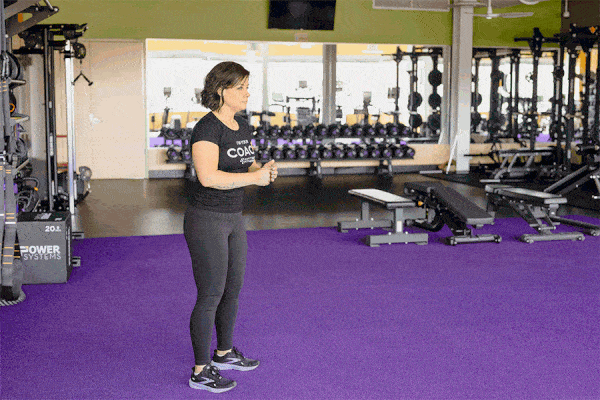
We’ll start on the ground with a squat jump. Use these steps to complete a squat jump:
- Stand with your feet hip-width apart.
- Bend your knees at a 90-degree angle, using your arms to stabilize yourself and gain momentum.
- Swing your arms back and jump off the ground with an explosive movement.
- Return to the 90-degree squat position.
- Complete two sets of 10 reps.
2. Broad Jump
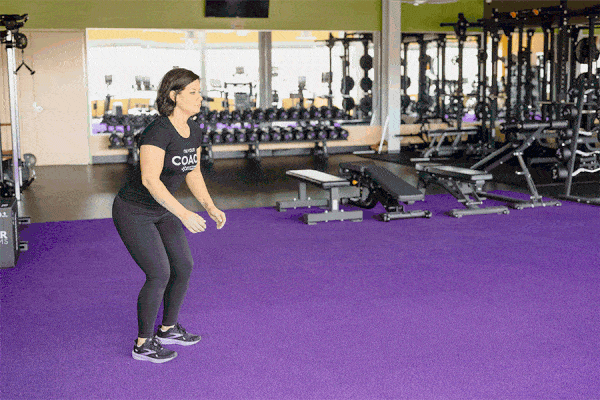
Once you’ve mastered the squat jump, spice things up with a broad jump. Instead of jumping vertically, you’ll jump horizontally. Here’s how:
- Start in the same position as the squat jump, with your feet hip-width apart and knees at a 90-degree angle. Use your arms to stabilize yourself and load up with momentum.
- Swing your arms backward, using your explosive power to leap forward.
- Land with both feet at the same time, returning to the starting position.
- Complete two sets of 10 reps.
3. Box Jump with Floor Box
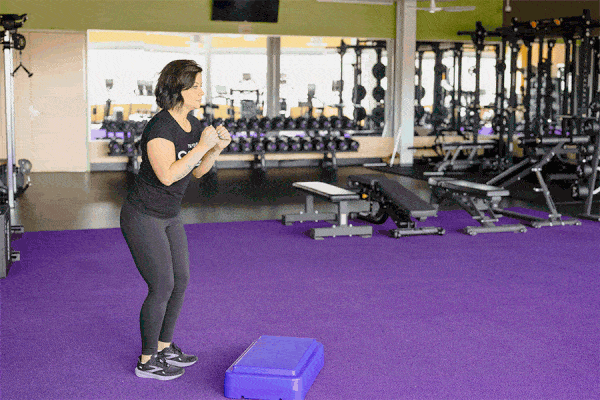
Now, you’re ready to introduce a box.
So, what’s a good height to start with box jump exercises? Start low, then work your way up to a height that’s comfortable for you. Using a box that’s too tall can interfere with your form and increase your risk for injury. Start with a plyo box that’s a few inches off the floor.
Remember to land with both feet softly on the box.
4. 12- and 18-Inch Box Jumps
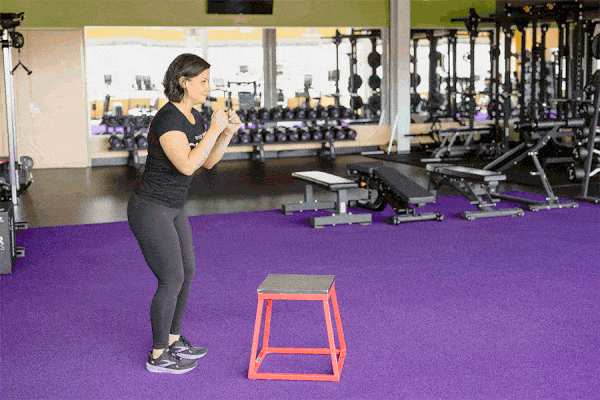
You’ll need to focus on driving momentum with your arms and creating lots of explosive power with your legs.
After you’ve mastered the 12-inch box, it’s time to crank things up to the next level. Give the 18-inch box jump a go. You’ve got this!
For an added challenge, try adding ankle weights or a weighted vest to your box jumping routine — starting back at a lower height, of course. As you gain more experience and get more comfortable with box jumps, you can work your way up to even taller heights.
Now that you’ve mastered how to do a box jump, are you ready to tackle your next challenge? Check out our guide to Get to Your First Pull-Up!
